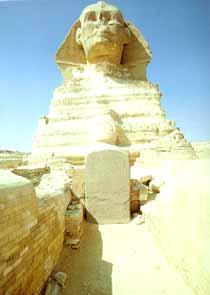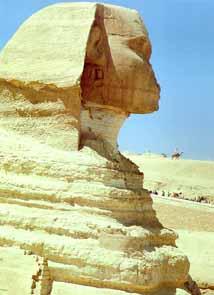|
Giza
Age of the Sphinx
PAGE 2
|
Dr
Schoch was not the first geologist to conclude that the Sphinx
site had been subject to rainfall erosion. One geologist even
resurrected Mariette's nineteenth century notion that the Sphinx
might be an old naturally eroded rock formation minimally dressed
up to look like a man-made carving. But Dr Schoch rightly emphasized
that the excavated enclosure in which the Sphinx stands proves
the monument to have been artificially carved in the first place
and then eroded - he presumes by rainwater.

Between
the Sphinx's forepaws, the Dream Stela still stands before
the badly eroded breast of the monument, under the much
better preserved head. |
Dr
Schoch first saw the site, from the viewing platform for visitors
to the Sphinx, in 1990. Work on site in winter 1992/3, alongside
seismographic work by others that produced some of those readings
suggestive of cavities in the bedrock, led him to believe
that the Sphinx and its enclosure walls showed unmistakable
signs of erosion by rainwater run-off, in much wetter times
than today or during the Old the date of carving, so the Sphinx
might be older than Dr Schoch's estimate of the time-span
of its erosion. Between about 5000 BC and 10,000 BC, Egypt's
climate fluctuated between relatively wetter and drier periods,
so there were wetter times than today's in which rain erosion
might have taken place if the Sphinx's body was already carved.
It should also he noted that even in Old Kingdom times up
to about 2300 BC, as is evidenced by plant and animal species
depicted in the tomb paintings, the weather of Egypt was wetter
than it has been since. But even now, winter rains pose something
of a threat in Egypt. The ditch alongside Khafre's causeway
evidently needed to be blocked in Old Kingdom times against
the possibility that rainwater drainage could run down into
the newly cut Sphinx enclosure, according to Professor Selim.
But Dr Schoch concluded that only the heavier rains before
5000 BC could have produced the erosion pattern of the Sphinx
and its enclosure walls.
Egyptologists, of course, can see no cultural context at all
in which the Sphinx could have been carved before 5000 BC,
or 3000 BC for that matter, and several good reasons for putting
its carving at about 2500 BC. Before about 10,000 BC, conditions
were cold and dry in Egypt, so erosion of a pre-existent Sphinx
is hard to imagine - indeed, the pre-existence of the Sphinx
before 10,000 BC is itself an idea all but impossible to entertain.
|
 |
Dr
Schoch made his ideas accessible to the world of Egyptology
in an article in the summer 1992 issue of the American magazine
KMT (which takes its title from one of the ancient Egyptian
names for Egypt, Kemet, with inserted vowels, meaning the
'Black Land' - the fertile soil watered by the Nile). He began
by observing that the Sphinx body and the walls of the enclosure
exhibit a pattern of weathering commonly associated with exposure
to rainwater run-off, showing a rolling and undulating vertical
profile with many vertical and sloping channels where joints
in the bedrock have been opened up.
He contrasted this situation at the Sphinx with the state
of weathering seen at other rock-cut features of the Giza
Plateau (such as various Old Kingdom tombs) where erosion
by windblown sand has picked out areas of poorer quality rock
to leave the ancient cut facades and doorways otherwise not
markedly damaged, and certainly not displaying the rounded
and undulating weathering of parts of the Sphinx.
These observations, as we shall see, naturally led on to arguments
about precisely what levels of the limestone beds of Giza
could be equated with what others in different parts of the
necropolis: for the beds do not lie horizontally all over
the whole site, but slope down from north to south and west
to east; moreover, ancient quarrying has left them discontinuous
over the area.
Thus it is not always easy to decide that, say, a certain
Old Kingdom tomb away from the Sphinx is cut in the same rock
as the body of the beast. When they are not of the same rock,
comparison of their states of erosion is more complicated
than simply saying that one is evidently eroded by the wind
since Old Kingdom times and the other eroded by water since
seven thousand or more years ago.
In his KMT article Dr Schoch took the view that the serious
erosion going on at the Sphinx today is a comparatively recent
phenomenon, of perhaps the past two hundred years, associated
with changes in the water-table and with pollution. He noted
that erosion by condensation of dew and subsequent evaporation,
bringing crystallization in the pores of the rock and spalling
off of surface flakes, is evidenced in the interiors of some
of the rock-cut tombs of Giza, but he concluded that this
process at the Sphinx today could not account for the highly
rounded weathering on the body and the enclosure walls that
indicate the action of rainwater over a long period.

The
profile of the Sphinx with similar light on the cheek:
the fundamental resemblance to Khafre's statue is clear.
|
|